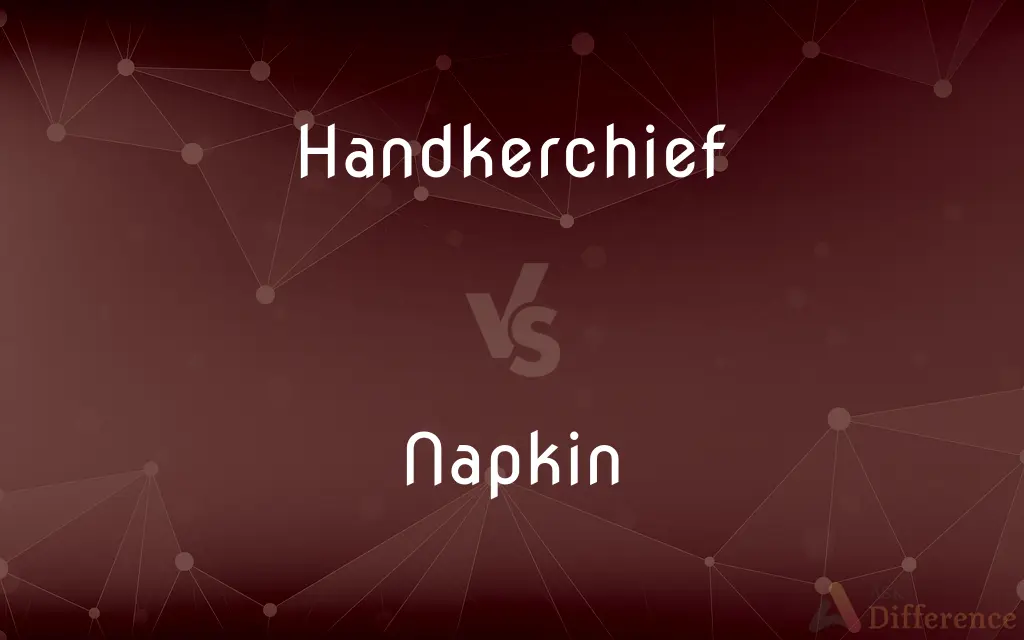Handkerchief vs. Napkin — What's the Difference?
By Tayyaba Rehman — Updated on September 25, 2023
A handkerchief is a small, usually square piece of cloth carried for wiping the face, nose, or eyes, whereas a napkin is a piece of cloth or paper used at meals to wipe the lips or fingers and protect clothing.

Difference Between Handkerchief and Napkin
Table of Contents
ADVERTISEMENT
Key Differences
Handkerchief and napkin both serve the purpose of cleaning but are used in distinctly different manners and contexts. A handkerchief is typically a small, square piece of cloth, often made of cotton or linen, carried for personal hygiene purposes such as wiping the nose, face, or hands. It is usually reusable and kept in one’s pocket or purse, emphasizing personal use and often acting as an accessory.
In contrast, a napkin is a piece of cloth or paper used primarily at meals. It is placed on the lap or held to the mouth to protect clothing and to wipe the lips or fingers. Unlike handkerchiefs, napkins, especially paper ones, are typically disposable. They are standard in dining settings, highlighting etiquette and cleanliness during meal consumption.
A handkerchief is often associated with personal cleanliness and is traditionally used over and over again after washing. It might be considered more personal and can also serve as a decorative accessory, sometimes even having sentimental value. It’s not uncommon to see handkerchiefs being used as a symbol of chivalry or kindness when offered to others in distress.
Conversely, a napkin, particularly a paper napkin, is generally used once and then discarded, emphasizing convenience and hygiene. Cloth napkins, while reusable, are still reserved for dining purposes and are washed between uses. Napkins are functional and are essential in maintaining cleanliness during meals, whether in a casual or formal dining setting.
In essence, while handkerchiefs are small, reusable pieces of cloth used for personal hygiene and often carried as accessories, napkins are specifically designed for use during meals, usually being disposable, and focus on protecting clothing and aiding cleanliness during eating.
ADVERTISEMENT
Comparison Chart
Definition
A small square piece of cloth used for personal hygiene.
A piece of cloth or paper used at meals to wipe lips or fingers.
Usage
Personal, often carried in pocket or purse.
Primarily at meals, to protect clothing and wipe mouth or hands.
Material
Typically made of fabric, often cotton or linen.
Can be made of cloth or paper.
Reusability
Generally reusable.
Cloth is reusable; paper is typically disposable.
Context
Personal cleanliness, can also be an accessory.
Dining, emphasizes cleanliness and etiquette.
Compare with Definitions
Handkerchief
A piece of fabric carried for personal hygiene or as an accessory.
She dabbed her tears with a lace handkerchief.
Napkin
Typically disposable piece of cloth or paper used for maintaining cleanliness while eating.
He unfolded the napkin and placed it on his lap before starting to eat.
Handkerchief
A reusable cloth used for personal cleanliness.
He always carries a handkerchief to manage his allergies.
Napkin
A dining accessory placed on the lap to catch food particles and prevent stains on clothing.
Every place setting at the formal dinner included a cloth napkin.
Handkerchief
Often made of cotton or linen, used to wipe away sweat, dirt, or moisture.
She handed him a clean handkerchief to wipe his dirty hands.
Napkin
A cloth or paper accessory, crucial in dining, used to wipe the mouth or hands while eating.
I always need extra napkins when eating barbecue ribs.
Handkerchief
A traditional accessory that can also serve as a symbol of kindness or chivalry.
He offered his handkerchief to the woman who was crying.
Napkin
A napkin, serviette or face towelette is a square of cloth or paper tissue used at the table for wiping the mouth and fingers while eating. It is usually small and folded, sometimes in intricate designs and shapes.
Handkerchief
A handkerchief (; also called a hankie or, historically, a handkercher) is a form of a kerchief or bandanna, typically a hemmed square of thin fabric which can be carried in the pocket or handbag, and which is intended for personal hygiene purposes such as wiping one's hands or face, or blowing one's nose. A handkerchief is also sometimes used as a purely decorative accessory in a suit pocket; it is then called a pocket square.
Napkin
A piece of cloth or absorbent paper used at table to protect the clothes or wipe the lips and fingers.
Handkerchief
A square of cotton or other finely woven material intended for wiping one's nose.
Napkin
A cloth or towel.
Handkerchief
A small square of cloth used especially for wiping the nose or mouth.
Napkin
A sanitary napkin.
Handkerchief
A large piece of cloth worn as a decorative article; a scarf.
Napkin
Chiefly British A diaper.
Handkerchief
A piece of cloth, usually square and often fine and elegant, carried for wiping the face, eyes, nose or hands.
Napkin
A serviette; a (usually rectangular) piece of cloth or paper used at the table for wiping the mouth and hands for cleanliness while eating.
Handkerchief
A piece of cloth shaped like a handkerchief to be worn about the neck; a neckerchief or neckcloth.
Napkin
A nappy (UK), a diaper (American).
Handkerchief
A piece of cloth, usually square and often fine and elegant, carried for wiping the face or hands.
Napkin
A small scarf worn on the head by Christian women (chiefly Roman Catholic and Eastern Orthodox) when entering a church, as a token of modesty.
Handkerchief
A piece of cloth shaped like a handkerchief to be worn about the neck; a neckerchief; a neckcloth.
Napkin
A little towel, made of cloth or paper, esp. one for wiping the fingers and mouth at table.
Handkerchief
A square piece of cloth used for wiping the eyes or nose or as a costume accessory
Napkin
A handkerchief.
Handkerchief
A small square piece of cloth used for wiping the nose, face, or hands.
He pulled out his handkerchief to wipe his sweaty forehead.
Napkin
To protect clothing; wipe mouth
Napkin
Garment consisting of a folded cloth drawn up between the legs and fastened at the waist; worn by infants to catch excrement
Napkin
A piece of cloth or paper used at meals for protecting the clothes and wiping the lips and fingers.
Please pass me a napkin; I spilled some sauce.
Napkin
Used in formal and casual dining settings to emphasize etiquette and cleanliness.
Using a napkin properly is considered good table manners.
Common Curiosities
Is a handkerchief typically used for personal hygiene?
Yes, a handkerchief is typically used for personal hygiene, like wiping the nose, face, or hands.
Can a handkerchief serve as an accessory?
Yes, a handkerchief can serve as an accessory and can have decorative and sentimental value.
Is a napkin primarily used during meals?
Yes, a napkin is primarily used during meals to protect clothing and to wipe the lips or fingers.
Are paper napkins typically disposable?
Yes, paper napkins are typically disposable, used once, and then discarded.
Can a handkerchief be considered a reusable item?
Yes, a handkerchief is usually made of fabric and is reusable after washing.
Is a napkin used to maintain cleanliness at the dining table?
Yes, a napkin is used at the dining table to maintain cleanliness by wiping the mouth and hands and protecting clothing from food spills.
Is a handkerchief typically square-shaped?
Yes, a handkerchief is typically small and square-shaped, suitable for carrying in a pocket or purse.
Share Your Discovery

Previous Comparison
Available vs. Accessible
Next Comparison
Establish vs. FixAuthor Spotlight
Written by
Tayyaba RehmanTayyaba Rehman is a distinguished writer, currently serving as a primary contributor to askdifference.com. As a researcher in semantics and etymology, Tayyaba's passion for the complexity of languages and their distinctions has found a perfect home on the platform. Tayyaba delves into the intricacies of language, distinguishing between commonly confused words and phrases, thereby providing clarity for readers worldwide.














































